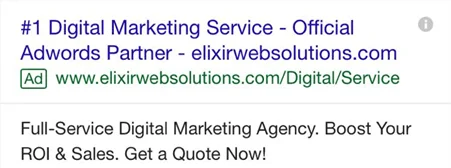
Great Google Ads are both an art and a science. Any marketer can you tell you that writing excellent ad copy with an emotional appeal requires research and a little sprinkle of creativity.
As marketers, we often sit down, hoping to find that spark of inspiration that will help us write killer ad copy. Ads that outperform your competition or at least grab some eyeballs.
And the contenders never stop growing in numbers!
The spends in search advertising alone reached 297.5 billion dollars in 2021. Raising the bar for every marketer to be better than the next. (Source)
If you are looking for ways to improve, this guide should help you consistently write successful and great Google ads.
Let’s begin with quick steps on how to write a great Google Ads (previously called Google AdWords) that grab attention in 2023.
Our readers and audience will have their take on our ad copy. They may feel completely different about it than we do.
Let’s begin by listing out the keywords you are targeting. Then the bulk of your time should be spent creating ad variations for testing them out in real-time.
There are broad categories that fit your variations.
⇒ Your first ad can be focused on the offer that you have at hand. Simply tell your audience what it is that you offer in as many words.
For example:

⇒ The second advertisement can elaborate on the services that you offer in more detail. Highlight the value add that you are offering. Let this make you different from your competitors, like free shipping, price locks, free quotes, etc.
For example:

In the above ad, the service provider cleverly uses the keywords and highlights how you can ‘receive a free price quote on your cell phone.’ They go on to include value-added services that sound like a solution to all the problems a customer might face in the process of selling a cell phone.
⇒ Go all out with your creativity for the third variation. This variation can work with emotions or the feelings of your audience.
For example:

In this ad, the appeal is in the headline.
Everyone wants to feel good about giving children the right toys or gifts, and this ad captures that tender feeling with its headline.
Creating these variations and tracking related data should help you gauge your audiences’ preferences with clarity. Giving you the green light to go all out with the best potential solution.
An ad is finished only when you no longer can find a single element to remove.
(Robert Fleege)
Basing your ads on research done to understand what language people prefer can prove to be a wise strategy. Check out the below tips to create ads that target clear language preferences.
What John Kuraoka says about advertising language is the best possible advice out there-
The second-best word is ‘you.’ The best word is the customer’s name.CLICK TO TWEET
Using language that talks directly to a user can make an enormous impact on your conversion rates. It makes you look active instead of passive.
Now let’s look at the science of great Google Ads.
A study by Wordstream highlights the top performing words most often used in the best performing Google Ads.
‘Shipping’ was a surprise for us too.
To build the case even further, check out these two ads on PPC services and tell us in the comments which one inspires more confidence in you.


For me, no doubt, it’s the first one. It’s simple. The ad makes me believe that I only pay when I receive clicks. Also, the first call to action is ‘start now’ and not ‘signup’ like the second ad.
Now, this brings us to words that you should use for the call to action.
In the same study by Wordstream, they analyzed a bunch of ads to arrive at what makes great Google Ads work in terms of CTA as well.

Here the choice remains with you. If your ad variation with the ‘signup’ CTA is garnering more response, then go for it.
However, it is good practice to know what has been working in the market for the top performing ads.
It is also not a good idea to use too many CTAs in your ad. More than one option or ask will confuse the reader. Don’t require organic searchers to work or make them have to decide which ad is best.
If you ask them to put more effort into understanding your offer then in all probability, the marketer who keeps it simple will win.
Take a closer look at the same ad, which has four CTAs. Some of the CTAs are relevant to the search query, and some are irrelevant ones.

When the keyword is ‘PPC ads,’ one can safely assume that they are not looking to signup or read a blog.
If they are looking for a blog, the keywords have more probability of including a question like, ‘How to run a PPC ad?’
The next topic for great Google Ads is punctuation.
Continuing with the same study, here are punctuation that are most commonly used in the best performing Google Ads.
Yup, exclamations won!
Let’s look at an example that shows us why exclamations work.

In the same ad, notice how they use the # sign instead of writing No. 1.
Using various symbols and signs can break a reader’s monotony. Looking at a ton of text can make a user feel saturated. Web searchers can easily experience information overload.
Use these symbols and punctuation to draw attention to your ad without overdoing it.
Various symbols like the trademark, copyright, and certified are also known to help inspire confidence in a viewer’s eyes.
Needless to say, if you don’t have any such certification, don’t use them for the sake of it. You could land in legal trouble.
One of Google’s main revenue streams is the PPC campaigns they run on their search engine.
Which means that every time someone clicks on your ad, they make money.
In their guide called ‘creative that clicks’ they mention the extensions that you can use when creating an ad.
When you are targeting a specific keyword, you want to make sure that the user lands on a page that continues to build on the promise that they clicked on.
Add the site-link that will take them directly to the designated landing page or a page on your website that continues to build the story.
As an example, when you use a sale to garner more clicks, it is important to lead the user to a page where the sale is happening.
If you lead them to the main page of your website and expect them to navigate to the page where the sale is, you’ve lost precious time of the user’s journey.
This works especially well for the service and the merchandise industry.
Look at these examples to see which one you would like to buy your golf balls from-


The one that is cheaper or the one that has 4620 reviews with a great overall rating?
Reviews are a way to build a stable and firm brand perception.
One of Google clients El Al, a leading airline in Israel, tested the extension and saw a 10% increase in CTR. (Source)
This extension can help you cut down your users’ journey by multiple steps.
There always will be people who are more comfortable having a conversation than completing a purchase online without ever connecting to a human being.
Apply this extension to increase your brand’s approach-ability and reduce the time it takes to connect with a potential customer.
Using this extension implies having a call center team that is highly trained and responsive in managing PPC ad customers.
When you use this feature, combine it with call tracking metrics and Conversation Analytics® services to optimize your campaign to its peak.
Optimizing for local SEO is the new buzzword. People are turning to the internet to find simple things like grocery stores or plumbers around them.
Using a location extension gives an advantage to companies that are targeting people in their neighborhood
This is almost imperative when you are targeting keywords with a particular location, state or area.
Google’s clients have seen a 10% increase in their CTR by adding a location extension. (Source)
Look at these ads to see different extensions that they have used to create their ads.

Companies with an app can use this extension to drive downloads and installations of their applications. Be careful to use this extension with the right keywords.
No one wants to download an app if they are simply using the internet for amusement unless they build the app for amusement.
When you are creating an ad, you do have the option of checking your preferred device as mobile. A mobile version has to be one variation you create.
But your work doesn’t end here. You need to check that your language, CTR and the landing page all correspond with what a mobile user wants to see.
For example, a CTR like ‘Buy From Phone’ works better than ‘Buy now’ for mobile devices.
It’s also possible that people searching on mobile need more information pronto. So you want to make sure that your ad is crisp, short and precise for your mobile audience.
Don’t limit your optimization to the ad, take your user on a mobile-optimized landing page or website for higher conversions.
The only way to optimize continuously your campaign is to keep measuring the performance of your great Google Ads.
Some questions that you can ask yourself along the way are:
What are you trying to improve by spending your marketing budget on PPC ad campaigns?
Even if your goal is as simple as running an experiment, it’s important to set a measurable target.
Use a single tool throughout the campaign to keep consistency in the results you see.
Try to establish your industry benchmarks with research and experimentation.
Google keyword planning helps you by telling you the bid per keyword and the level of competition for each keyword to help you plan your campaign and look at projected results.
For example, if your bid was lower than the highest bid and your ad is still on top, it means that your ad has a better user experience than the highest bidder.
It is advisable to keep some elements consistent in your variations to know which part of your ad has an effect on the overall result. If you change every single element in the ad then you can lose track of what is making your ad click.
You could try variations in your
And the list can go on…
You need a substantial data size to base your decision on. Run the test long enough to see visible patterns and ensure you really have great Google Ads. But not so long that you lose sight of the data points and start seeing anomalies.
Before you start your great Google Ads campaign
The top 3 paid advertising spots get 46% of the clicks on a page. (Source)
A well-crafted ad with research to back it up has a higher chance of being a success in the competitive ad space.
Do you think PPC can work for your brand? Tell us more about your PPC ads experience so far in the comments.

Book A Quick 15 Minute Call,
And We’ll Show You How To Unlock The Power Of Every Conversation.